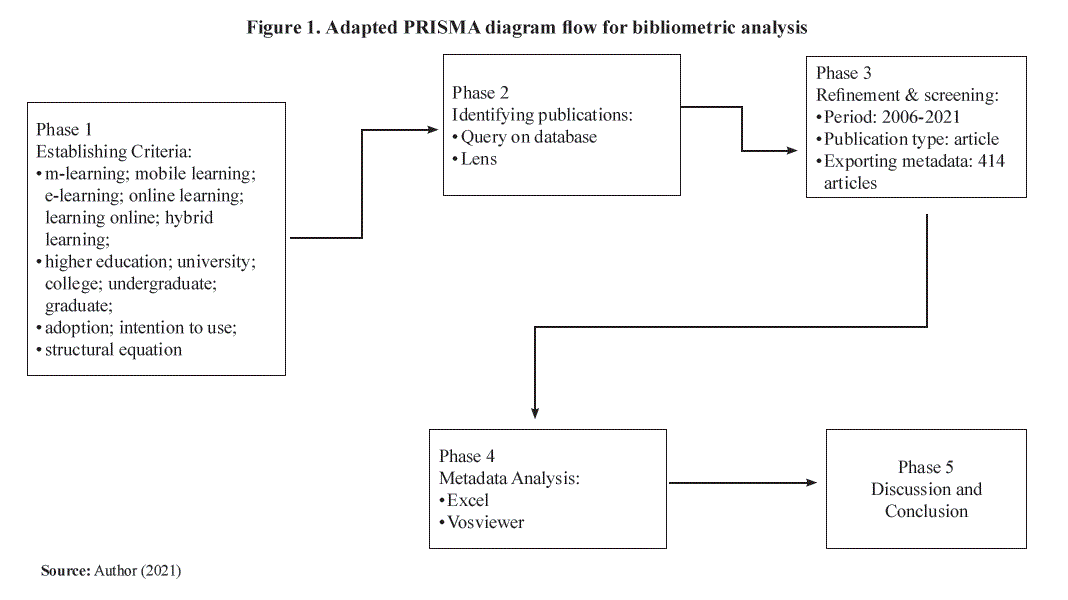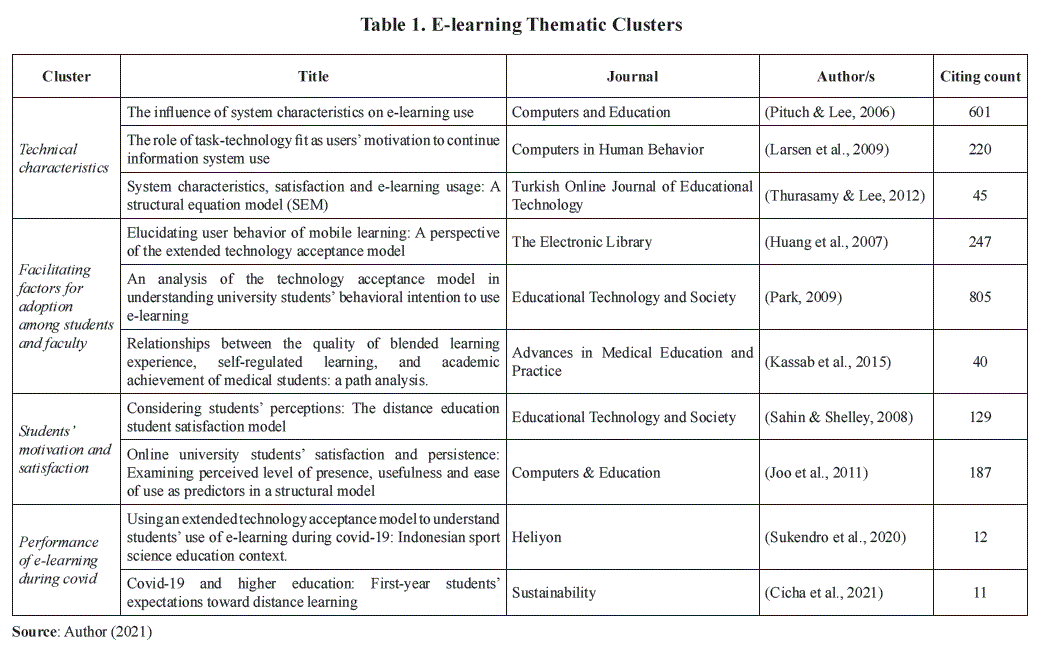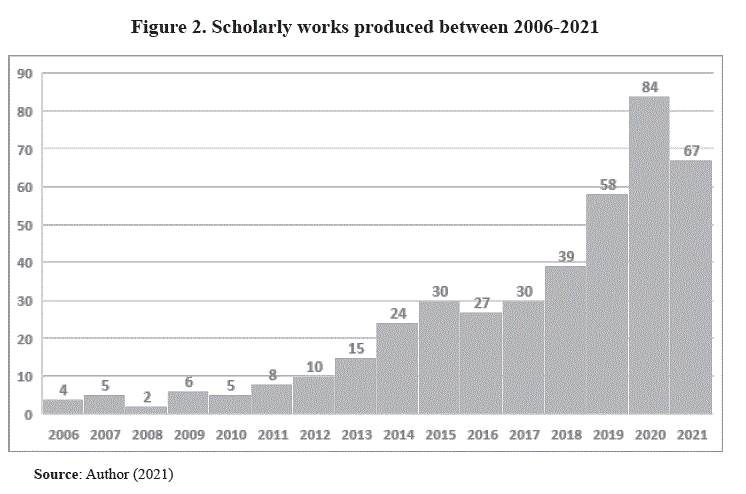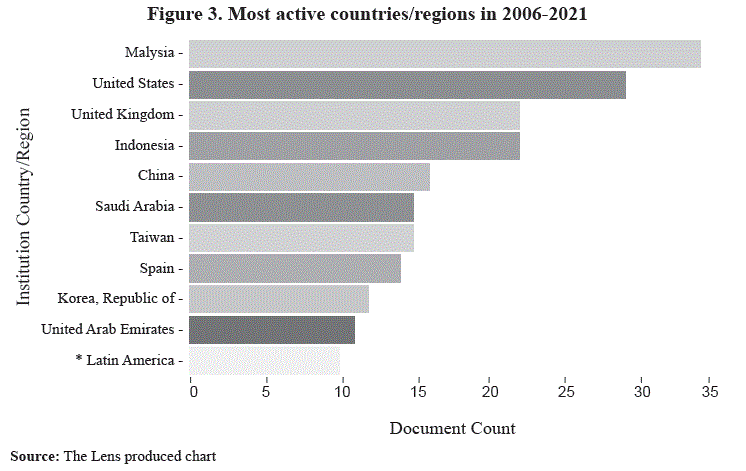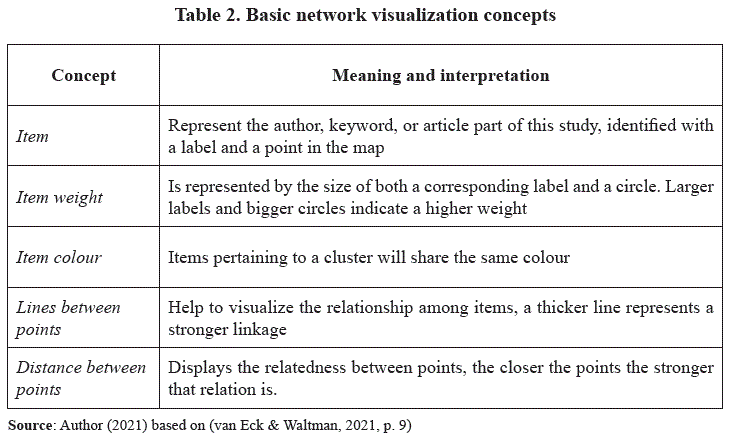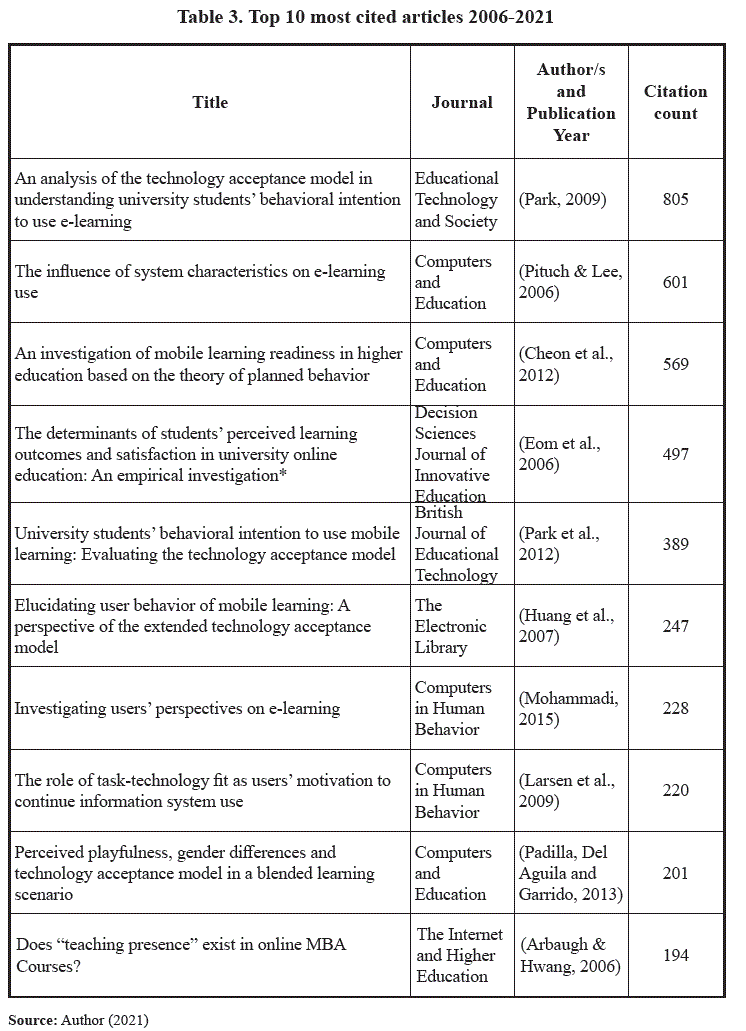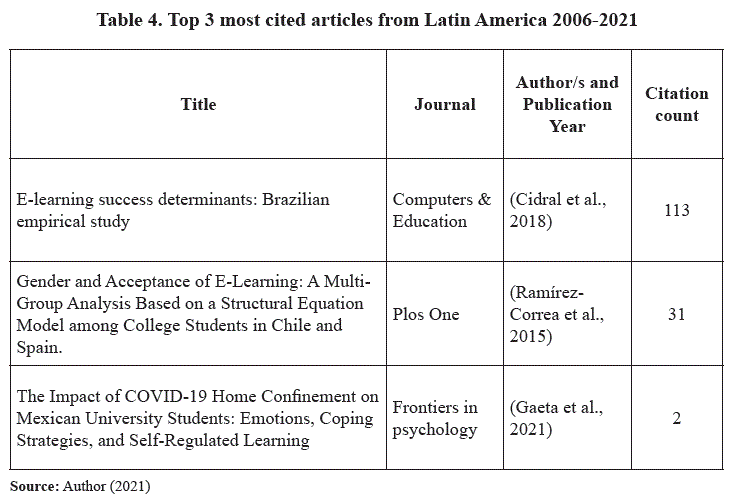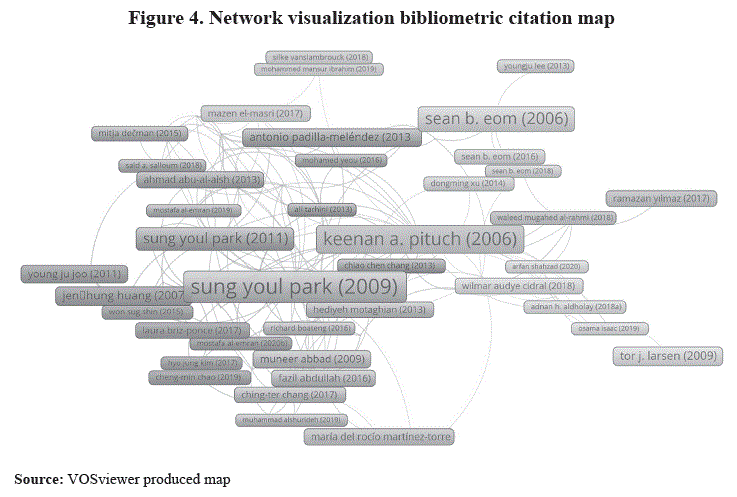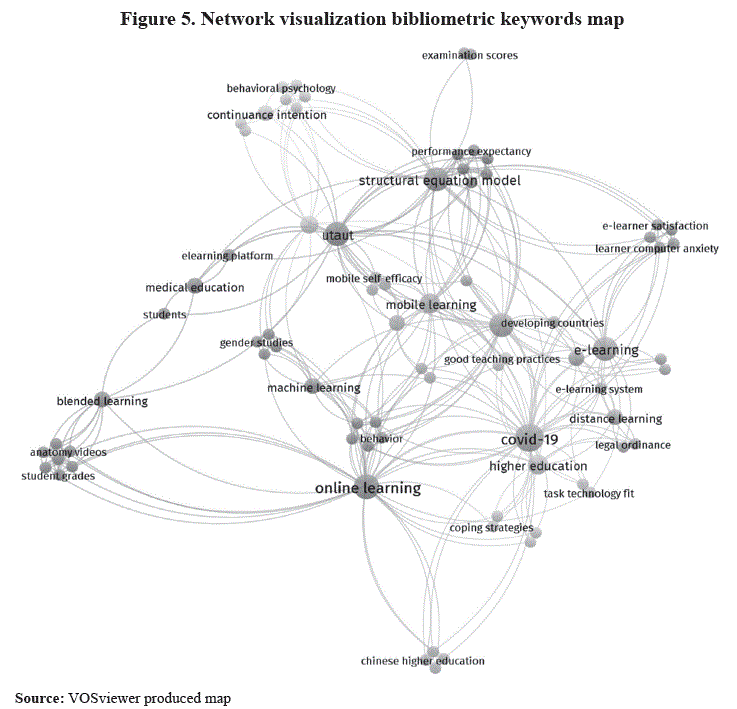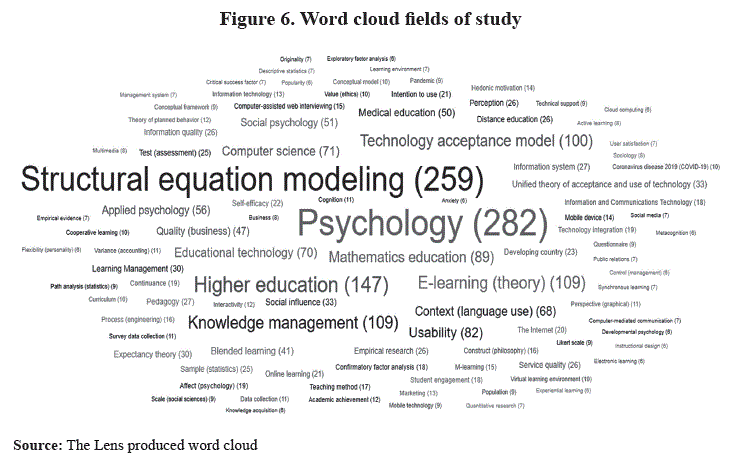Serviços Personalizados
Journal
Artigo
Indicadores
-
 Citado por SciELO
Citado por SciELO -
 Acessos
Acessos
Links relacionados
-
 Similares em
SciELO
Similares em
SciELO
Compartilhar
Educación Superior
versão impressa ISSN 2518-8283
Edu. Sup. Rev. Cient. Cepies vol.8 no.2 La Paz set. 2021
ARTÍCULOS CIENTÍFICOS
A bibliometric analysis of the adoption and use of e-learning
in higher education
Un análisis bibliométrico sobre el uso y la adopción de la educación
en línea en la enseñanza superior
Ortega Azurduy, Martin
Lecturer in Management and Research Methods Banking Academy of Vietnam - International
School of Business martin.doctorate@gmail.com Hanoi, Vietnam
Fecha de Recepción: 9 de agosto de 2021 Fecha de Aprobación: 9 de septiembre de 2021 en reunión de Comité Editorial
Abstract
This bibliometric analysis identifies and presents the articles that have given shape to the current research trends on the adoption and use of e-learning in higher education using structural equation modeling. Metadata for scholarly work was obtained from The Lens database, and network visualization was produced with VOSviewer. This study includes 414 articles published between 2006 and 2021. The results consider four thematic clusters, a list of the 10 most cited articles, a word cloud for fields of study, and two network visualization maps (citation and keywords). As the first bibliometric paper that addresses articles using structural equation modeling techniques, the main contribution of this paper is to quantitatively synthesize the large quantity of bibliometric metadata obtained and present the state, structure, and trends in the study of the adoption and use of e-learning in higher education. Specifically, this paper will introduce the most influential authors and papers, key themes, current and future areas of research. In conclusion, this paper should serve as a resource for future research, as well as, to be an example of how to carry out a basic bibliometric analysis.
Keywords: Bibliometric Analysis, E-learning, Structural Equation Modelling, Higher Education.
Resumen
Este análisis bibliométrico identifica y presenta los artículos que han dado forma a las tendencias actuales en la investigación de la adopción y el uso del e-learning en la educación superior utilizando modelos de ecuaciones estructurales. Los metadatos para este trabajo académico se obtuvieron de la base de datos The Lens, y la visualización de redes se produjo con VOSviewer. Un total de 414 artículos publicados entre 2006 y 2021 se incluyen en este estudio. Los resultados de este estudio incluyen: cuatro grupos temáticos, una lista de los 10 artículos más citados, una nube de palabras para áreas de estudio, dos mapas de visualización de redes (citas y palabras clave). Siendo el primer trabajo bibliométrico que aborda específicamente artículos que usan técnicas de modelos de ecuaciones estructurales, la principal contribución de este trabajo es sintetizar cuantitativamente la gran cantidad de metadatos bibliométricos obtenidos y presentar el estado, la estructura y las tendencias en el estudio de la adopción y el uso del e-learning en la educación superior. Específicamente, este trabajo introducirá los trabajos y autores más influyentes, temas centrales, y áreas de investigación actual y futura. En conclusión, este trabajo debe servir como un recurso para futuras investigaciones, así como, para ser un ejemplo sobre cómo llevar a cabo un análisis bibliométrico básico.
Palabras Clave: Análisis Bibliométrico, Educación en Línea, Modelos de Ecuaciones Estructurales, Educación Superior.
1. Introduction
UNESCO’s report “COVID-19: reopening and reimagining universities” (UNESCO, 2021) on the imprint of the pandemics in higher education highlights the enabling role e-learning had on tertiary education by aiding Universities and Colleges to switch to remote teaching and learning across the globe. Concern for the development and adoption of online learning ranks high among the trends and challenges universities worldwide face today, namely: a trend towards “increased online/ distance/hybrid learning,” and concern for the need to build up support for “teacher training in online/distance learning,” “improvement in the infrastructure and availability of devices for online/distance learning” and “guidelines/tools/ teaching-learning materials to develop online/ distance learning” (pp. 25–26).
Therefore, there is still an increased urgency to gain an understanding of how and when the need for e-learning in higher education, its intention to use, its use, and adoption occur. The goal of this article is to present the outcomes of a bibliometric study systematically carried out by making use of The Lens, an online platform that aggregates and links scholarly produced work and scientific patents. For this study, the author is specifically interested in reviewing bibliography corresponding to quantitative research studies using structural equation modeling (SEM) techniques for data analysis.
SEM is a statistical approach for testing hypotheses that allows for a number of sophisticated, specific, flexible, and complex techniques for research design and data analysis conducive to going from model specification, to estimation, to an evaluation of fitting data, to model manipulation or re-specification, to end up on an interpretation of the indexes obtained and their meaning as outcomes of research. (Hoyle, 1995, pp. 1–15)
A bibliometric analysis is a scientific methodology assisted by computers, broadly used in academia for mapping out the state of the art in any given field; its main characteristic is to identify trends over a period in a given topic (Han et al., 2020, p. 2). To do this, a large number of metadata that covers all the scientific publications relating to the topic is used to identify relations among authors, articles, or citations. This is done in a quantitative analysis making use of advanced statistics to portray patterns extracted from that metadata. It is different from a systematic literature review or a meta-analysis in the sense that it does not review in a qualitative manner the contents of the articles, but it does so in a quantitative way, meaning that a statistical software is used to quantify the metadata and the results are shown in the form of visualization maps, statistics, and charts.
Proprietary large databases such as Scopus or the Web of Science are commonly used to do a bibliometric analysis and represent a large investment for researchers, especially those in the global South. However, there are more databases of much easier access, user friendly and free. This paper will use one of them, Lens.org.
This paper will answer specifically the following research questions: (RQ1) who are the most influential authors in the study of the adoption and use of e-learning in higher education using a structural equation modeling statistical approach in their research? (RQ2) what are the most important thematic areas in this area of knowledge? (RQ3) what are the future or potential areas for research in the field?
2. Materials and methods
Method and data source
By using metadata extracted from The Lens, this bibliometric study concentrates on published articles dealing with the use and adoption of e-learning in higher education and adopting structural equation modeling for their quantitative analysis.
The Lens is a lesser-known aggregator of metadata in a field dominated by behemoths like Scopus and Web of Science; it offers a comprehensive database and is extremely user-friendly. A large number of publishers and data partners have afforded The Lens to index more than 236+ million scholarly works (dissertations, reports, articles, etc.) and 3.5+ million patents (Lens.org, 2021).
Searching and extracting the articles
This study was carried out in July and August of 2021. It was divided in four phases (Figure 1): The first, doing preliminary qualitative research and generating a number of keywords to use on the next phase; by making use of The Lens, the second phase started by formulating a number of queries to select the most appropriate articles for the bibliometric study and the final query entered to the database was as follows:
Abstract: ( ( m-learning OR ( “mobile learning” OR ( “blended learning” OR ( e-learning OR ( elearning OR ( “online learning” OR ( “learning online” OR “hybrid learning” ) ) ) ) ) ) ) AND ( “higher education” OR ( university OR ( college OR ( undergraduate OR graduate ) ) ) ) ) AND ( ( use OR ( adoption OR “intention to use” ) ) AND ( “structural equation” ) )
Further filters were introduced to refine the results. It was established a timeframe “year published” to focus on the period 2006 to 2021 and a second filter “publication type” for selecting journal articles only. The final run for this query resulted in 414 scholarly works selected. In the third phase, the researcher extracted the metadata from The Lens database and manually reviewed one by one all the 414 articles’ abstracts to find unrelated or non- relevant articles, but none were found and the whole set was accepted for the next phase with the oldest article dating from 2006 and the latest one published on July 15th, 2021. In the fourth phase, Excel and VOSviewer were used for a more complex bibliometric analysis.
3. Analysis of data
Descriptive analysis
As it can be observed in Figure 2, there is a flourishing interest among academics for using Structural Equation Modeling to research on the use and adoption of e-learning in higher education, with 20.3% of the work published in 2020 and 16.2% in 2021 due to the increasing interest on E-learning as a consequence of the COVID pandemics.
Geographic distribution
Most of the academic production of research in e-learning in higher education comes from Malaysia (34), the US (29), the UK (22), and Indonesia (22). China (16), Saudi Arabia (15), Taiwan (15) have also achieved high scientific productivity in the period 2006-2021. On the other hand, Latin America as an aggregate appears at the bottom of the chart with a combined count of 10 articles originating from Brazil (5), Mexico (4), and Chile (1) (Figure 3).
Thematic clusters
Research on e-learning use and adoption can be divided into four clusters, the first one with a strong concentration on the technical characteristics of an e-learning system; a second cluster directed towards studying the factors facilitating its adoption among students and faculty; a third one reviewing students’ motivation and satisfaction; and, a fourth cluster on the use and performance of e-learning in times of COVID. In Table 1, representative articles for the 4 clusters are presented further here below, in this article.
On the initial analysis, four thematic clusters were identified: technical characteristics, facilitating factors for adoption among students and faculty, student’s motivation and satisfaction, and the performance of e-learning during COVID (Table 1).
In the first cluster, the researchers consider specific technical characteristics for the system used, such as system functionality, system interactivity, and system response among college students in Taiwan (Pituch & Lee, 2006); task-technology fit in the IS continuance intention of Norwegian university’s faculty (Larsen et al., 2009); and, information quality and system quality on the continuance intention of undergraduate in Malaysia (Thurasamy & Lee, 2012).
Articles in the second cluster extend original technology acceptance models to education identifying facilitating factors for the adoption of technologies in higher education, for example, perceived mobility value for mobile learning among students in Taiwan (Huang et al., 2007); e-learning self-efficacy, e-learning attitude and system accessibility in the Korean students’ intention to use e-learning (Park, 2009); and self- regulated learning, quality of blended learning experience of a Moodle-based virtual learning environment (VLE) among medical students in Bahrain (Kassab et al., 2015).
Student’s motivation and satisfaction are central topics in the third cluster, where certain attributes such as flexibility and computer expertise in the satisfaction of Turkish students with distance education tools (Sahin & Shelley, 2008); teaching, social and cognitive presence on the student’s satisfaction in a Korean online university (Joo et al., 2011); and, the effect of post-adoption expectations and satisfaction on the continuance intention of e-learning among Iranian students (Tiyar & Khoshsima, 2015).
Finally, the fourth cluster is formed by articles dealing with the COVID effect on e-learning in higher education in different local contexts around the world, including predicting the use of e-learning Indonesian sport science students (Sukendro et al., 2020), the effect of inequalities in access and use among underrepresented minorities (URM) and non-URM in the USA (Kim et al., 2020); and, the expectations of Polish undergraduate students in the switch to online learning (Cicha et al., 2021).
In the next section of the bibliometric study, three types of analysis will be carried out: citation analysis, keyword analysis, and word cloud analysis. A network map will be exhibited to visualize the different connections among the individual items and the nodes. In order to interpret the network visualization, there are a number of concepts to be familiar with and these are shown in Table 2.
Citation Analysis
This section of the study categorises articles by the number of articles that have cited a given piece of scholarly work. Citations are highly representative for impact, as the most cited works exercise a strong influence on the scope and form the foundation for future research. On Table 3, 10 of the most referenced articles in the period 2006-2021 are shown ordered by the total number of articles that have cited a particular work (citation count).
Table 4 exhibits the most cited articles originating from Latin America. Among all articles included in the study, 10 articles correspond to authors from Mexican, Brazilian and Chilean institutions, among them: University of Guadalajara-MX (3), Pontifical Catholic University of Rio de Janeiro-BR (2), University of São Paulo-BR (2), and Catholic University of the North-CH (1).
Figure 4 presents a network visualization map for citation where only papers with 20 or more citations have been included. As it can be observed from Figure 4 and Table 3, the most cited paper by Prof Sung Young Park (2009) from Konkuk University works as a central node (green cluster) on the network visualization map. In his paper, Prof. Park studies the effect of “e-learning self-efficacy, subjective norm, system accessibility, perceived usefulness, perceived ease of use and attitude on the behavioral intention to use e-learning,” using a structural equation model (SEM) based on the Technology Acceptance Model (TAM). This paper is key to establish TAM as a theoretical basis to research the adoption of e-learning. A second node (blue cluster), establishes the Theory of Planned Behavior (TPB) as a tool for researching students’ perceptions, namely the effect of “attitude, subjective norm, and behavioral control” on the intention to adopt mobile learning (Park et al., 2012). The Green and Blue clusters stem both from papers written by the same author. A third cluster (Orange) has its origin in the work of Keenan (2006); the paper departs from TAM and explores a system’s characteristics as determinants for the use of an e-learning system.
Keyword analysis
In the keyword analysis section, the most frequently used keywords are visualized, 78 items were taken into account for the map. Ten clusters were identified based on their co- occurrence (Figure 5). Based on their size and centrality, some of the most commonly used keywords are “e-learning,” “online learning,” “mobile learning,” “blended learning,” and “machine learning” that represent the different ways in which academics have clustered their research in connection with the enabling technology. The appearance of “COVID-19,” amongst the most frequent keywords, signals the effect the global pandemics are having on online learning in higher education worldwide. Further “COVID-19,” “e-learning” and “technology acceptance model” are representative of the green cluster which points to the current scope of research in this field due to the pandemics.
Fields of study analysis
This part of the analysis is done using a word cloud (Figure 6) for the fields of study provided by The Lens, showing the most representative terms for all accessible text in a given article. Microsoft Academic uses machine learning to compute the fields of study by analyzing the complete (or available) string of text in an article. Word cloud is a visual representation where the importance of a field is evident by the font size which corresponds to the number in parentheses (frequency count). Psychology (282), structural equation modeling (259), higher education (147), e-learning (theory) (109), knowledge management (109), and technology acceptance model (100) are the most significant fields among the 414 articles in this study. The fields of study word cloud are convergent and complementary to the keyword analysis. SEM appears as a node for the violet cluster and as the second (structural equation model 259) most frequent keyword. Continuance, expectation, behavior, and satisfaction are psychological aspects (psychology 282) in the adoption and use of e-learning.
4. Discussion
Most influential authors (RQ1)
The 3 most cited articles (Cheon et al., 2012; Park, 2009; Pituch & Lee, 2006) with over 500 citations each indicate the importance this topic has in the research agenda with an average citation per year rate of 63, 67, and 40 respectively. The proximity in the bibliometric citation network analysis between Pituch & Lee (2006) and Park (2009) both indicate how connected they are as a sort of core for the network.
A comparison between the most influential articles at the global level, those in LatinAmerica, and the geographical distribution show that the study of the adoption and use of e-learning using structural equation modelling techniques has not yet thriven, which represents a gap and an opportunity for researchers in higher education.
Most important thematic areas (RQ2)
The keywords network gives a quick overview of the many sub-topics that have been studied in the context of e-learning in higher education using structural equation modeling, a rather novel quantitative approach that is receiving growing interest among practitioners as unveiled in the field of study analysis. The broad use of the technology acceptance model (TAM) (Mohammadi, 2015; Park, 2009; Sukendro et al., 2020) and the unified theory of acceptance and use of technology (UTAUT) (Abu-Al-Aish & Love, 2013; Briz-Ponce et al., 2017) in the study of e-learning adoption became evident through the word cloud and network visualization.
Contrasting these results with the thematic clusters, it can be observed a transition in the scope of research from technology-oriented research founded on the use of TAM and UTAUT as a framework, to searching for understanding the more education-related facilitating factors, to student-centric research on their motivations and satisfaction, to assessing the adoption and performance of e-learning in a very specific yet paradigm-changing event such as the global COVID pandemics.
Future or potential areas for research (RQ3)
The COVID-19 effect is observed among the current trends (Akour et al., 2021; Cicha et al., 2021; Rizun & Strzelecki, 2020; Shahzad et al., 2021; Sukendro et al., 2020) and is likely to push our understanding of the facilitators for the (intention to) use e-learning in higher education with an emphasis on particular aspects of the human psyche, with concepts such as enjoyment, computer anxiety, satisfaction, and perceived self-efficacy.
The transition in the research scope -mentioned earlier above- points towards the need to devise and test newer models of technology adoption specific for higher education. These models will be greatly influenced by the experiences lived and the research carried out during the course of the global pandemics and the resulting lessons learned.
Opportunities and limitations with the Lens
Limitations of this study should be discussed, and a limitation of this research relies on the number of articles that are accessible through The Lens. Even though, counting with over 236+ million scholarly works metadata through the platform and considering the large overlapping among different platforms, there is still a number of works that are only available on other platforms such as Scopus or Web of Science. A second limitation involved the reduced number of keywords metadata that was available through The Lens for the selected articles, an aspect that was solved by using “fields of study” which is produced by Microsoft Academic through machine learning parsing of accessible text strings (metadata + articles) and available from The Lens.
Despite this limitation of The Lens, the current partnerships with publishers and other metadata providers such as ORCID, Crossref, PubMed, Core, Microsoft Academic, and the Initiative for Open Abstracts make it possible for The Lens to continuously grow their database. Furthermore, with over 236M scholarly works metadata -as a point of comparison Clarivate WOS holds 182M records (Clarivate, 2021)-, and many more becoming available due to the trend among publishers to switch to an open- access model and making more of their metadata freely available, The Lens is an excellent tool for bibliometric studies.
5. Conclusions
To conclude, the specific goal of this article to systematically carry out a bibliometric study making use of The Lens platform was achieved and presented in the results section. Furthermore, the most influential authors were identified (RQ1), key thematic areas were presented and reviewed (RQ2), and potential areas for future research were introduced (RQ3).
Future research and novice researchers in the adoption and use of e-learning will benefit from this bibliometric study, particularly because by synthesizing a large amount of metadata it identifies the most influential works in this field (RQ1), it maps the current research trends that may be a good starting point for their own research (RQ2), and it helps them to visualize the connections between different authors and their research, as well as, helping them to provide a foundation for their new research (RQ3).
During the pandemics, the research has concentrated on the performance of e-learning as an enabler for distance learning in higher education. There is an increased interest in understanding the impact of psychological aspects, as drivers and facilitators, on the students’ and lecturers’ adoption of e-learning. Research is building upon traditional theories of technology and innovation diffusion theories such as the theory of planned behavior (TPB) (Cheon et al., 2012), technology acceptance model (TAM) (Park, 2009), and the unified theory of acceptance and use of technology (UTAUT) (Briz-Ponce et al., 2017). Introducing pedagogical and psychological aspects resulting in constructs more focused on the teaching-learning paradigm central in higher education and moving from studies on technical characteristics (Pituch & Lee, 2006; Thurasamy & Lee, 2012) to research on user characteristics (Joo et al., 2011; Kassab et al., 2015).
Bibliography
Abu-Al-Aish, A., & Love, S. (2013). Factors influencing students’ acceptance of m-learning: An investigation in higher education. International Review of Research in Open and Distance Learning, 14(5), 82–107. https://doi.org/10.19173/irrodl.v14i5.1631
Akour, I., Alshurideh, M., Al Kurdi, B., Al Ali, A., & Salloum, S. (2021). Using machine learning algorithms to predict people’s intention to use mobile learning platforms during the COVID-19 pandemic: Machine learning approach. JMIR Medical Education, 7(1). https://doi.org/10.2196/24032
Arbaugh, J. B., & Hwang, A. (2006). Does “teaching presence” exist in online MBA courses? Internet and Higher Education, 9(1), 9–21. https://doi.org/10.1016/j.iheduc.2005.12.001
Briz-Ponce, L., Pereira, A., Carvalho, L., Juanes-Méndez, J. A., & García-Peñalvo, F. J. (2017). Learning with mobile technologies – Students’ behavior. Computers in Human Behavior, 72, 612–620. https://doi.org/10.1016/j.chb.2016.05.027
Cheon, J., Lee, S., Crooks, S. M., & Song, J. (2012). An investigation of mobile learning readiness in higher education based on the theory of planned behavior. Computers and Education, 59(3), 1054–1064. https://doi.org/10.1016/j.compedu.2012.04.015 [ Links ]
Cicha, K., Rizun, M., Rutecka, P., & Strzelecki, A. (2021). Covid-19 and higher education: First-year students’ expectations toward distance learning. Sustainability (Switzerland), 13(4), 1–20. https://doi.org/10.3390/su13041889
Cidral, W. A., Oliveira, T., Di Felice, M., & Aparicio, M. (2018). E-learning success determinants: Brazilian empirical study. Computers and Education, 122, 273–290. https://doi.org/10.1016/j.compedu.2017.12.001 [ Links ]
Clarivate. (2021). Web of Science platform: Web of Science: Summary of Coverage. https://clarivate.libguides.com/webofscienceplatform/coverage. [ Links ]
Eom, S. B., Wen, H. J., & Ashill, N. (2006). The Determinants of Students’ Perceived Learning Outcomes and Satisfaction in University Online Education: An Empirical Investigation. Decision Sciences Journal of Innovative Education, 4(2), 215–235. https://doi.org/10.1111/j.1540-4609.2006.00114.x
Gaeta, M. L., Gaeta, L., & Rodriguez, M. del S. (2021). The Impact of COVID-19 Home Confinement on Mexican University Students: Emotions, Coping Strategies, and Self-Regulated Learning. Frontiers in Psychology, 12. https://doi.org/10.3389/fpsyg.2021.642823 [ Links ]
Han, J., Kang, H.-J., Kim, M., & Kwon, G. H. (2020). Mapping the intellectual structure of research on surgery with mixed reality: Bibliometric network analysis (2000–2019). Journal of Biomedical Informatics, 109. https://doi.org/10.1016/j.jbi.2020.103516 [ Links ]
Hoyle, R. H. (Ed.). (1995). Structural Equation Modeling: Concepts, Issues and Applications. SAGE Publications. [ Links ]
Huang, J. H., Lin, Y. R., & Chuang, S. T. (2007). Elucidating user behavior of mobile learning: A perspective of the extended technology acceptance model. Electronic Library, 25(5), 585–598. https://doi.org/10.1108/02640470710829569 [ Links ]
Joo, Y. J., Lim, K. Y., & Kim, E. K. (2011). Online university students’ satisfaction and persistence: Examining perceived level of presence, usefulness and ease of use as predictors in a structural model. Computers and Education, 57(2), 1654–1664. https://doi.org/10.1016/j.compedu.2011.02.008
Kassab, S. E., Al-Shafei, A. I., Salem, A. H., & Otoom, S. (2015). Relationships between the quality of blended learning experience, self-regulated learning, and academic achievement of medical students: A path analysis. Advances in Medical Education and Practice, 6, 27–34. https://doi.org/10.2147/AMEP.S75830 [ Links ]
Kim, S., Rosenblith, S., Chang, Y., & Pollack, S. (2020). Will ICMT access and use support URM students’ online learning in the (Post) covid-19 era? Sustainability (Switzerland), 12(20), 1–14. https://doi.org/10.3390/su12208433
Larsen, T. J., Sørebø, A. M., & Sørebø, Ø. (2009). The role of task-technology fit as users’ motivation to continue information system use. Computers in Human Behavior, 25(3), 778–784. https://doi.org/10.1016/j.chb.2009.02.006
Lens.org. (2021). About The Lens. https://about.lens.org/ [ Links ]
Mohammadi, H. (2015). Investigating users’ perspectives on e-learning: An integration of TAM and IS success model. Computers in Human Behavior, 45, 359–374. https://doi.org/10.1016/j.chb.2014.07.044
Padilla-Meléndez, A., Del Aguila-Obra, A. R., & Garrido-Moreno, A. (2013). Perceived playfulness, gender differences and technology acceptance model in a blended learning scenario. Computers and Education, 63, 306–317. https://doi.org/10.1016/j.compedu.2012.12.014 [ Links ]
Park, S. Y. (2009). An analysis of the technology acceptance model in understanding University students’ behavioral intention to use e-Learning. Educational Technology and Society, 12(3), 150–162.
Park, S. Y., Nam, M. W., & Cha, S. B. (2012). University students’ behavioral intention to use mobile learning: Evaluating the technology acceptance model. British Journal of Educational Technology, 43(4), 592–605. https://doi.org/10.1111/j.1467-8535.2011.01229.x
Pituch, K. A., & Lee, Y. K. (2006). The influence of system characteristics on e-learning use. Computers and Education, 47(2), 222–244. https://doi.org/10.1016/j.compedu.2004.10.007 [ Links ]
Ramírez-Correa, P. E., Arenas-Gaitán, J., & Rondán-Cataluña, F. J. (2015). Gender and Acceptance of E-Learning: A Multi-Group Analysis Based on a Structural Equation Model among College Students in Chile and Spain. PLOS ONE, 10(10), e0140460. https://doi.org/10.1371/journal.pone.0140460 [ Links ]
Rizun, M., & Strzelecki, A. (2020). Students’ acceptance of the covid-19 impact on shifting higher education to distance learning in Poland. International Journal of Environmental Research and Public Health, 17(18), 1–19. https://doi.org/10.3390/ijerph17186468
Sahin, I., & Shelley, M. (2008). Considering students’ perceptions: The distance education student satisfaction model. Educational Technology and Society, 11(3), 216–223.
Shahzad, A., Hassan, R., Aremu, A. Y., Hussain, A., & Lodhi, R. N. (2021). Effects of COVID-19 in E-learning on higher education institution students: the group comparison between male and female. Quality and Quantity, 55(3), 805–826. https://doi.org/10.1007/s11135-020-01028-z [ Links ]
Sukendro, S., Habibi, A., Khaeruddin, K., Indrayana, B., Syahruddin, S., Makadada, F. A., & Hakim, H. (2020). Using an extended Technology Acceptance Model to understand students’ use of e-learning during Covid-19: Indonesian sport science education context. Heliyon, 6(11). https://doi.org/10.1016/j.heliyon.2020.e05410
Thurasamy, R., & Lee, J. (2012). System Characteristics, Satisfaction and E-Learning Usage: A Structural Equation Model (SEM). Turkish Online Journal of Educational Technology, 11(2), 196–206. [ Links ]
Tiyar, F. R., & Khoshsima, H. (2015). Understanding students’ satisfaction and continuance intention of e-learning: Application of expectation–confirmation model. World Journal on Educational Technology: Current Issues, 7(3), 157–166. https://doi.org/10.18844/wjet.v7i3.203
UNESCO. (2021). COVID-19: reopening and reimagining universities, survey on higher education through the UNESCO National Commissions. https://unesdoc.unesco.org/ark:/48223/pf0000378174 [ Links ]
van Eck, N. J., & Waltman, L. (2021). Manual for VOSviewer version 1 .6.17. Leiden University. [ Links ]













